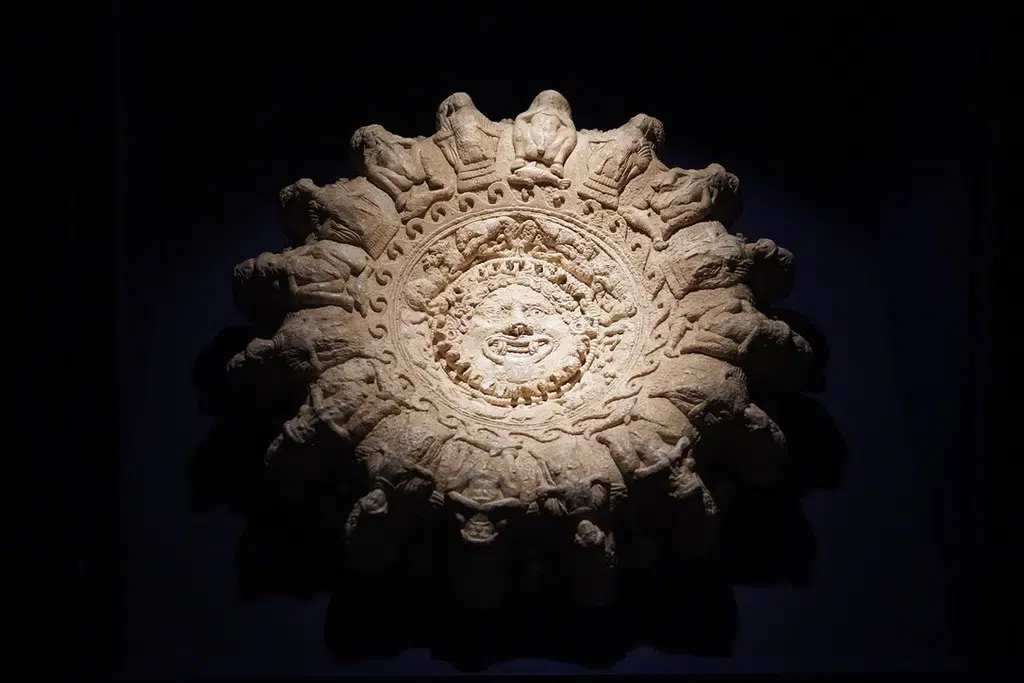
A bronze, hanging oil lamp found in a ditch near the town of Cortona, Central Italy is far older than previously thought and depicts the Greek god Dionysus, a new paper published in De Gruyter’s Etruscan and Italic Studies argues.
The lamp was recovered together with a damaged and inscribed bronze plaque in 1840, but the dating of the objects has caused some consternation among the archaeological community. It is generally accepted that the lamp and the plaque are of different dates. In 1988, radiography revealed the lamp and plaque have different chemical compositions and thus were not made from the same batch of bronze.
However, the dating of the lamp and the meaning of its elaborate decoration have been the cause of some controversy since its discovery. Now, however, PhD student Ronak Alburz and Associate Professor Gijs Willem Tol of the University of Melbourne, Australia, have utilized several literary sources and other iconographic evidence to carry out a comprehensive new analysis of the item.
The Cortona lamp is formed roughly in the shape of a chandelier, measuring 60 centimeters across and weighing nearly 60 kilograms. It has its origins in the Etruscan civilization of Archaic Etruria, a region of Central Italy corresponding roughly to present-day Tuscany and part of Umbria. Etruscan civilization flourished from around 900 BC until it was gradually absorbed into the Roman Republic after about 400 BC.
The Cortona artifact is a large, intricately designed bronze hanging lamp that might have been part of rituals paying homage to the Greek god Dionysus, but it took a long time to reach this conclusion. https://t.co/u50feeiMKX
— Ancient Pages (@AncientPages) April 10, 2024
The Cortona lamp, in particular its iconography, has not succumbed to a satisfactory explanation for two main reasons. Firstly, very few similar items have been unearthed in Etruscan or ancient Greek art, making it a challenge to draw useful comparisons, and secondly, the lamp has no context, having been discovered with only an inscribed bronze plaque that is from a much later period.
This vagueness means there is no further information about the building it was potentially used in or how it was related to or associated with other artifacts. Researchers were thus limited to examining individual decorative motifs displayed on the lamp.
Etruscan lamp depicts Greek god Dionysus, authors claim
In their thorough re-evaluation, Alburz and Tol identified additional similarities with other iconography that indicate the lamp was created around 480 BC, much earlier than many previous estimates.
The pair also claim earlier scholars were incorrect in identifying the lamp’s sixteen bull-horned figures as the Greek river god Achelous. By drawing on a range of literary sources and presenting new iconographic evidence, they show that Dionysus, the ancient Greek god of wine and pleasure, was also typically depicted with the features of a bull.
They hence claim that the lamp depicts the Dionysian thiasus, the ecstatic retinue of Dionysus who are often portrayed as inebriated revelers.
Lead author Alburz said, “The lamp was probably an object associated with the mystery cult of Dionysus. Its decoration represents the Dionysian thiasus, perhaps engaged in a cultic performance in the cosmos of the mysteries in celebration of Dionysus.”
See all the latest news from Greece and the world at Greekreporter.com. Contact our newsroom to report an update or send your story, photos and videos. Follow GR on Google News and subscribe here to our daily email!



